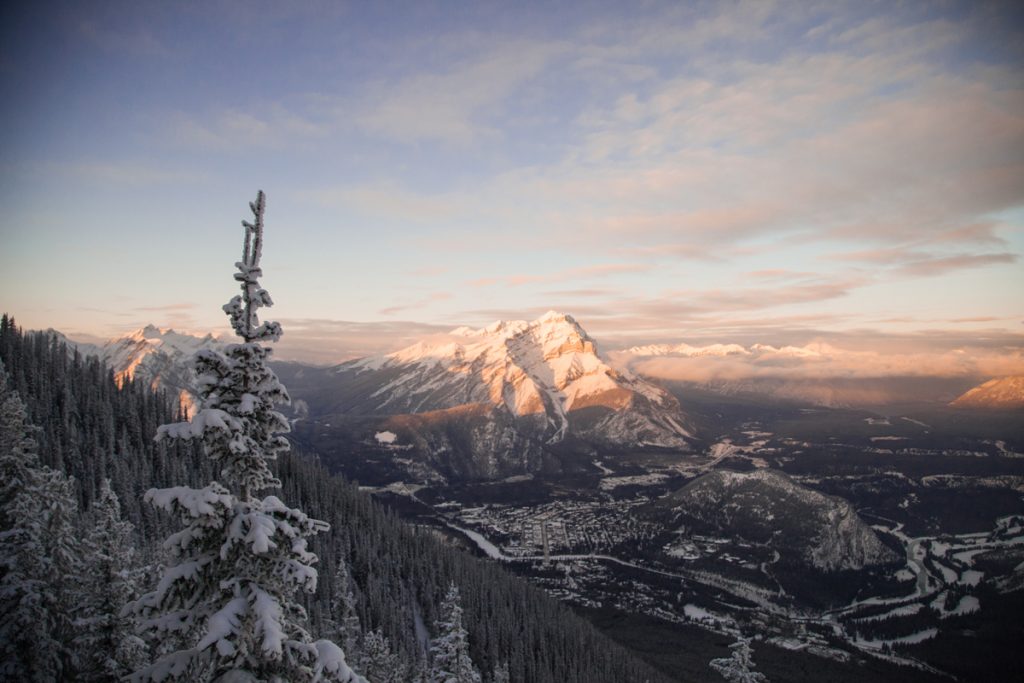Ascending Cascade Mountain with Canadian Rockies Mountain Guides
Founder Patrick Jerome helps us up the iconic east side of the peak

As expected for mid-June, there are flowers on the Bow Valley floor in Alberta, Canada, but the surrounding mountains are covered in snow. Because of this recent snow fall, our climb will be a little more difficult, says our guide Patrick Jerome. The founder of Canadian Rockies Mountain Guides, Jerome, is leading us up the east side of Cascade Mountain—an iconic peaks overlooking Banff. “Because we’ll be climbing as two parties on this route today,” Jerome explains, “our best strategy is to stay close together and communicate where the loose rock is to mitigate the potential for having any rockfall.” Jerome continues, “the good news is that with a bit of wind and little bit of sun, this rock dries faster than you think.” Having worked as a Public Safety Specialist for several of the mountain parks in Western Canada, Jerome is an expert. An ACMG/IFGMA (Association of Canadian Mountain Guides and International Federation of Mountain Guides Association) for nearly a decade, he now spends most of his time guiding clients in the mountains.
“A lot of people are unaware that mountain guiding has been a legitimate profession in Canada for close to 120 years,” Jerome continues. In fact, Canada became the first country outside of Europe to be recognized by the International Federation of Mountain Guides in 1972. Jerome is a “full mountain guide” (as the IFMGAs are often referred to) and is certified internationally to guide in the mountains in any season for various objectives such as alpine climbing, rock climbing, backcountry skiing and mechanized skiing.

Though he’s qualified to take us on many an adventure, today we are rock climbing. In order to get to the climb, we must walk up a drainage that’s flowing lightly from an above waterfall, but more than usual due to the recent storm and the warm temperatures. We pass over an icy, snowy clearing that is covered in pine needles, branches and other debris that got torn apart during an avalanche. Obviously during the winter, this area is high-risk, but for today the snow is not the issue—it’s loose rock.
Jerome explains his biggest worry for the climb, “The limestone, like most of the rock around the Canadian Rockies, is highly variable in quality, especially in the spring. It is a soft, sedimentary rock and because of the snow and ice that blankets the side of mountains for most of the winter, the rock is prone to becoming broken and shattered. This is a direct result of the freeze-thaw cycle that is part of overall processes of erosion.”

We reach the bottom of the climb and put on our helmets, harnesses and rock-climbing shoes. Rated 5.9, the climb we are doing (called Valley View) isn’t particularly hard in grade, but we are doing seven pitches with two climbing parties close together. “Another very crucial component to this job is risk communication, that is describing the risks in the briefing prior to the trip but also as the events, conditions and risks are unfolding ahead of us,” Jerome explains.

As we climb higher, another party shows up and begins below us. This worries Jerome and the rest of us as we’ve witnessed the “chossy” (climber slang for loose rock) bits all day. Their presence is not a danger to us, rather to themselves as we will inevitably be rappelling back down on top of them. “This isn’t uncharacteristic of an inexperienced climbing party who are goal-oriented and unable to identify direct fall line hazards of moving people and ropes. In short, I hope they get smart,” says Jerome. Luckily, a few pitches after a few rocks have been dislodged, common sense prevails and the climbing party retreats to avoid an accident.
This situation is one of the various reasons to hire a guide. “We are trained and certified to enhance your margins of safety,” Jerome tells us. (In fact, Canada has a serious certification process, with guides required to have six to eight years’ training in order to be certified.) Jerome continues, “We know what and where the most worthwhile routes are, when the conditions are optimal to climb or ski in these places and will ultimately provide you with best chance of being successful. We are dialed into making the best use of your valuable time.”

As we reach the top of our climb, we take in the stunning view. The green, gray and blue hues of trees, rocks and lakes are mesmerizing. “Most of these routes are named for good reason,” Jerome says. “As you can see Valley View’s name wasn’t random.” After a few high fives and plenty of photo-taking, we “rap down” the climb and walk back down the drainage. Since the morning and with the melt of the snow, the flow of the stream has risen drastically. We finish the day with wet feet, but entirely satisfied. “My best days of guiding are with people who are open to new experiences and allow me to push their limits gently outside of their comfort zone from time to time, allowing them to experience outcomes that they didn’t realize were possible. You can tell when someone has a breakthrough and they get to that place—it’s exceptionally rewarding.”
Peruse the various summer and winter adventures Canadian Rockies Mountain Guides offer online.
Images by John Price












